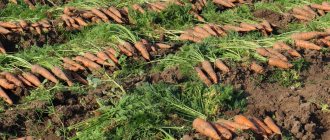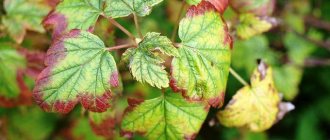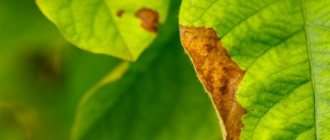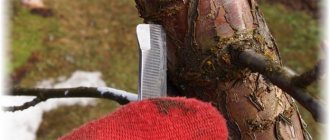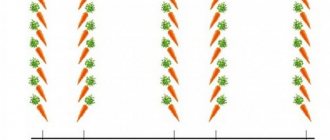Almost all varietal carrots are highly resistant to diseases and pests. Problems during cultivation arise when agricultural cultivation techniques and care rules are not followed.
Infection not only reduces yields, but also leads to the accumulation of the pathogen in the soil, increasing the risk of infections spreading to other crop plants.
That is why it is important to be able to recognize the main diseases of carrots in order to carry out timely prevention and select effective treatment.
Rots, their description and treatment
Diseases in this group develop against a background of high humidity and sudden changes in air temperature. These are only fungal infections that spread quickly and can remain in the soil for a long time. Treatment is effective only in the early stages of infection.
White
Photo:
The second name of the disease is sclerotinia. The causative agent of the infection is the pathogenic fungus Sclerotinia sclerotiorum, the spores of which are activated at high humidity and temperature in the range of 15-22 oC.
Most often, carrots are infected during storage, destroying the entire crop, but infection can occur at any stage of growth. The disease can be identified by a characteristic white fluffy coating, which gradually spreads over the entire root crop.
Black and white compactions appear on the surface, the carrots become deformed and dry out. Contaminated vegetables should not be eaten.
To avoid crop contamination, after harvesting root crops, they should be treated with Tiram fungicide (TMTD) at the rate of 6-8 kg of the drug per 10 liters of water. This concentration is enough to spray 1 ton. If the volume is small, you can use regular chalk dust.
As a preventative measure, it is important to observe crop rotation and also avoid fertilizing with phosphorus compounds only. It is advisable to give preference to potassium fertilizers, as this macronutrient reduces the risk of infection.
Gray
The disease is also known as botrytis rot, or botrythiosis. Carrot infection is caused by a fungus of the genus Botryttis cinerea. The disease usually occurs when crops are stored near cabbage.
The risk of infection increases when vegetables are kept in a cold room. When gray rot spores enter, the root crop softens and the flesh acquires a brown tint. Gradually, the carrots become deformed and rot, becoming unsuitable for consumption.
To combat gray mold, the necessary fertilizing should be applied to the soil in a timely manner; in the spring, preventive spraying should be carried out with a 1% solution of Bordeaux mixture or copper sulfate.
When harvesting, it is important to avoid mechanical damage; it should be stored at a temperature of 2-5C. Every year you need to disinfect the cellar and whitewash the walls.
Dry
The disease is better known as carrot blight. The causative agent of the infection is the fungus Phoma rostrupii Sacc. Infection begins with plant tops, which acquire a characteristic reddish tint.
The stem becomes brittle and dry, and then dies. Rot spreads through the tissues of the root crop, causing it to soften. When harvesting, you can notice dry black-blue ulcers on the skin; the infection can spread during storage in the basement or cellar.
According to statistics, when infected with Phoma, up to half of the carrot planting of the first year can be saved, and the plants in the second year are destroyed in 100% of cases.
Fighting methods:
- Before harvesting, treat all root crops with a solution of copper sulfate in a ratio of 1:45;
- carefully sort and discard carrots before harvesting;
- Avoid storage in low temperature areas;
- During the season, carry out 1-2 treatments of the bed with a 1% solution of Bordeaux mixture.
As a preventative measure, it is recommended to fertilize the plantings in a timely manner with phosphorus and potassium compounds and observe crop rotation. After harvesting carrots, the tops should be burned to avoid the spread of infection in the area.
Alternaria, or black rot
A dangerous disease caused by a fungus of the genus Radicina. Provoking risk factors for the spread of infection are hot and humid weather with regular precipitation and wind.
Brown spotting of carrots often develops against the background of black rot. When infected, the tops become lethargic and gradually dry out. Fungal spores can remain in root crops and soil for a long time.
Due to Alternaria blight, the sugar and carotene content in the pulp decreases, dark spots appear on the surface of the carrots, which gradually soften during long-term storage in high humidity conditions.
In the early stages of the disease, treatment of the beds with copper containing preparations (Bordeaux mixture, Hom, Oksikhom, copper sulfate) demonstrates great effectiveness.
The treatment is carried out in two stages with an interval of 10-12 days in accordance with the dosage on the package. For prevention, it is important to control the nitrogen content in the soil and avoid using fresh manure for fertilizing.
To maintain moderate humidity, it is recommended to drain the soil with river sand or expanded clay and carry out regular loosening.
Carrot diseases
Carrots belong to the group of table root vegetables, are grown everywhere, are well stored, used raw and after heat treatment. Used for preparing salads, main courses and desserts. It owes its beneficial qualities to its high content of provitamin A. To obtain a good harvest and ensure maximum preservation of the vegetable, you should know about the main diseases to which carrots may be susceptible, for their timely prevention and treatment.
Bacteriosis
Symptoms of wet rot of carrots may appear already in the field, and intensify during storage. Vegetables gradually become covered with dark, watery lesions at the base or top, resulting in the entire carrot being affected. As tissues decompose, they become mucus-like and emit a foul odor. Rotten specimens, resembling mush, infect neighboring ones. Erwinia carotovora reproduces well in conditions of high humidity and temperatures from 25 to 30ºC. These are single or chain rod-shaped bacteria with a flagellum that die at temperatures above 50 ºC. In the soil, the infection lurks in organic residues. Control measures include using only clean planting material and selecting undamaged, healthy root crops for storage.
Fungal diseases
Black rot (alternaria blight) affects many umbrella crops. Carrots are usually affected by it in the second year of the growing season. Brown lesions appear on the underside of the leaf blades, with a dark green coating consisting of spore carriers. As the lesions grow, they lead to the death of the leaves, and the fungus Alternaria radicina penetrates the stem and reaches the root crop. Conidiophores have few branches, conidia are ovoid or club-shaped, and can be chain or single. In storage, dry black indentations appear on diseased vegetables, clearly separated from healthy tissue. When the queen cells are damaged, the testes dry out or their seeds are infected. Alternaria prefers warm, humid weather. Since the source of infection is the affected queen cells and seeds, they should be treated. Mycosis successfully survives unfavorable conditions on plant remains, so they are destroyed.
Cercospora blight of carrots affects seeds and plants in the first year and is widespread. In July, small, round or unshaped brown spots with a red-brown edge and a light core appear on the leaf blades, up to 2 mm in diameter. A gray coating appears at the bottom of the leaf, formed by sporulation of the fungus Cercospora carotae. Conidiophores are light olive, united in bunches. Colorless conidia are unicellular and multicellular. As the area increases, the spots become lighter and the leaf blades curl. In the testes, the petioles and stems are covered with yellow-brown depressed spots. Lesions hinder growth, and individual specimens die. Mycosis spreads greatly during rains at a temperature of 23-24 ºC, remains viable in the soil on organic matter and on seeds. The occurrence of carrot disease is prevented by destroying vegetable residues, deep plowing, using fungicides, and thermal and chemical treatment of seeds.
Stemphylliosis parasitizes many types of cultivated plants. In carrots it is localized on all above-ground organs, the manifestations of the disease are different. The spots on the leaf blades are dark, concentric, with a black coating, causing them to die. The plaque consists of sporulation and mycelium. The mycelium Stemphyllium botryosum is colorless or yellow-brown, the hyphae are multicellular. Petioles, stems and even inflorescences are strewn with irregularly shaped dark brown spots, and then completely covered with plaque. The seedlings die from stemphylosis, and the testes do not produce seed material. Mycosis is spread by conidia and overwinters on plant debris in the ground. Infection is prevented by observing crop rotation, destroying crop residues, collecting seeds only from healthy testes, and dressing. The seed plants are treated with plant protection products.
Fomoz (dry rot) affects all organs, roots, including the testes, and is especially destructive. Whitish, then darkening stripes appear on the stems and leaves, on which numerous pycnidia are formed. Bib Phoma rostrupii gradually penetrates into root crops, forming slightly deep gray-brown spots on their surface; on the cut tissue, the tissue is dry and darkened. Pycnidia are formed on testes, inflorescences and seeds. Rotting in the storage begins, voids filled with white mycelium appear under the decaying tissue. Affected queen cells should be eliminated, as they either die or the seeds from them will be contaminated. Control measures come down to compliance with the rules of agricultural technology and the use of fungicides.
Rhizoctonia (felt disease, red rot) affects many root crops during growth and storage. Symptoms can be noticed even during cultivation. The apex of the root crop under the epithelial tissues begins to be affected by dark lead spots, turning red, they deepen and are filled with colorless mycelial plaque. Which thickens and acquires a purple hue, reminiscent of felt. The hyphae of Rhizoctonia violacea are thick and branched. Then small, but large numbers of purple sclerotia are formed, which persist until favorable conditions occur. The affected root crop dries out and sometimes rots. In diseased plants, leaf blades, losing turgor and chlorophyll, fall off. Since mycosis spreads quickly, especially in conditions of high temperature and humidity on heavy soils with a low pH value, foci of this disease are noted. The development of rhizoctoniosis slows down when the thermometer reading is below 10ºC. Once in the vegetable storehouse, the infected carrots continue to deteriorate, picking up other pathogens. Liming the soil, following storage rules, cleaning the soil and dressing the queen cells helps prevent the problem.
White rot (sclerotinia) is one of the most common diseases and poses a great danger to vegetables in storage, intensively affecting the crop 1-2 months after planting. When there is excess moisture on heavy soils, it parasitizes root crops during their growth, covering them with mucus and a cottony whitish coating, on which black sclerotia and droplets of liquid subsequently appear. Once in the vegetable storehouse, Sclerotinia sclerotiorum forms foci of disease, as it quickly moves from vegetable to vegetable, especially if storage rules are not followed. Plant protection products and fungicides kill the pathogen. The rules of crop rotation and the treatment of queen cells prevent the spread of crops.
Gray rot (botrythiosis) infects during the growing season and storage. Appearing as round or angular spots, Botrytis cinerea takes over the entire root crop, covering it with fluffy gray-green mold on which sclerotia protrude. This stage retains the ability to germinate for up to 20 months. The parasite penetrates its victim both in the field and in storage, especially if the carrots have been exposed to hypothermia due to untimely harvesting. The testes cannot withstand the development of the fungus on them and wither very quickly. The source of infection is hidden in organic residues, in the soil, in storage. Prevention of carrot disease is through properly carried out agrotechnical measures and disinfection of storage.
, we work for you
Rhizoctoniosis, or scab
Among gardeners, the disease is better known as felt rot because of the characteristic symptoms in the later stages of infection. The causative agent of this dangerous infection is the fungus Rhizoctonia violaceae, which is often found on turnips, parsley and beets.
Signs of rhizoctoniasis:
- grayish spots appear on the surface of the root crop, penetrating into the deep layers of the pulp;
- carrots become covered with a purple coating and black dots;
- the leaves turn yellow and dry out, the tops fall off prematurely;
- After harvesting, dense brown spots appear on the surface of the carrots, under which active rotting occurs. The plaque becomes fluffy and looks like felt.
To avoid disease, the soil must be loosened regularly and stagnation of water must be avoided. Even before planting, it is recommended to add sand and peat in equal proportions to increase aeration.
When the first signs of infection are detected, the bed should be treated with a 1% solution of Bordeaux mixture or copper sulfate at the rate of 10 liters of the product for every 100 m2. Sorting and selecting root crops for winter storage to prevent pathogens from reaching healthy root crops.
Preventive actions
- Compliance with crop rotation requirements.
It is not recommended to plant carrots in the same place from year to year; the planting location should be changed.
- Compliance with agricultural technology.
The soil for carrots should be deoxidized and rich in humus, but not too waterlogged, but not dry either. Do not allow the soil to become loaded; this leads to weakening of the root crop and the appearance of diseases. Before harvesting, apply only phosphorus-potassium fertilizers.
- Treating seeds before sowing carrots, when using your own seeds.
Antifungal prophylaxis. 20-30 days before harvesting, treat the planting with copper-containing preparations (Abiga-pik, Hom, Agricola, Burgundy liquid, etc.).
- Harvesting.
A favorable harvest must meet a number of requirements, in particular: a dry day, an average temperature of approximately +5C°, the tops are cut at a distance of about 1.5-2 cm from the base of the root crop, the carrots are sorted (discarding damaged ones for processing) and dried.
- Storage area processing.
Before placing the harvest, you should fumigate or simply disinfect the storage area.
- Storage conditions.
For the most favorable storage conditions for carrots, you need a well-ventilated room and a temperature regime of 0-+ 2C°.
- Clearing the soil of vegetation.
After harvesting, it is necessary to remove the remaining vegetation for the winter to avoid pathogens.
- High-quality weeding and thinning.
Physiological damage to root crops
Cracking of root vegetables
Such damage to root vegetables as cracking, bifurcation or hairiness should be considered physiological, while carrots also remain edible, without losing their taste and beneficial qualities, but they are still not recommended for storage.
Measures to avoid physiological damage
Measures that can be taken to avoid physiological damage are preventive and corrective in nature:
- Do not overdry the soil, and if this happens, do not try to moisturize it at once. If the soil becomes dry, distribute watering evenly over several days.
- You should not apply nitrogen fertilizers or manure after shaping carrots.
- To dilute heavy soil in the fall, you should dig up the beds about 10-15 cm by adding sapropel (3 kg of dry mixture / 1 square meter). In addition, it is necessary to add soil deoxidizers (fluff lime or others) and soil acidifiers.
Cercospora
A common disease of carrots, it occurs everywhere, regardless of the climate in the region. The causative agent of the infection is the fungus Cercospora carotae, which can remain in the ground for a long time. Pathogen spores can be carried by wind or insects.
The peak of infection occurs at the beginning of July; in the early stages, the disease can be identified by the appearance of small rusty spots with a light center on the tops. Then the tops begin to become very curly, the leaves fall off, and the root crops stop growing.
Spots appear on the surface of the carrots, which are a gray coating. Further spread of cercospora occurs during crop storage.
For treatment, the chemical fungicides Quadris and Bravo demonstrate the greatest effectiveness. The recommended consumption rate of the drug is 1 ml per 6 liters of water, spraying is carried out at the rate of 5 liters of working solution per 10 m2.
As a preventive measure, you should dig up the area deeply before sowing crops in spring, and also collect and destroy all plant debris in a timely manner.
Brown spot
A fungal disease that develops when carrot planting technology is not followed. Infection is caused by a pathogenic fungus of the genus A. Dauci. The first signs of brown spot appear on the tops of the plant - the leaves acquire a brownish color and become dry.
Then the infection spreads to the root crop, dark brown spots appear on it, leading to rotting in the ground. After harvesting, carrots quickly rot and become unsuitable for food.
The most reliable way to avoid brown spot is to observe crop rotation and also carry out pre-sowing seed preparation. To do this, they should be soaked for 10 minutes in water at a temperature of 45-50 oC, and then transferred to a container with cold liquid.
It is recommended to spray the first shoots with a biological immunostimulant (Epin-extra, Ivin and Immunocytophyte). If a spot infestation has been detected in the area, then all plant residues must be burned and the bed should be treated with a 3% solution of copper sulfate.
Carrot diseases: photo description of black rot (alternaria blight)
Carrot diseases: photo description of black rot (alternaria blight)
Description of the disease. Black rot is a fungal disease that can destroy young seedlings already at the stage of 3-4 leaves and even earlier - during the germination phase. After this, the disease will slowly dry out the leaves, as a result of which they will die, causing the harvest to quickly disappear. In addition, black rot of root crops can develop directly during storage of carrots. Those fruits that have any external defects or damage are the first to be removed. Not only will a significant part of the crop perish as a result, but what remains of it will lose any digestible presentation. Due to a particularly severe infection, by spring, all root crops without exception will be completely or partially affected by this destructive fungus, because the infection comes primarily from the soil and seeds, where, by the way, it can remain for an indecently long 8 years.
It is not difficult to recognize the disease. During storage, a gray, mold-like coating appears on the carrot roots. Clearly visible black dry spots appear on the root crops themselves, somewhat similar to dents. Most often they can be found on the top of the fruit.
Description of the causative agent of the disease. The fungus that causes black rot is extremely widespread. It is difficult to find a place where gardeners would not have problems with it. The fungus has a standard spore size and brown or brown colored conidia. The fungus is most dangerous in its usual environment: at a temperature of 22-25°C and with air humidity above normal.
It is believed that in addition to carrots, this fungus also affects parsley, celery and other umbrella crops. But this is not entirely true, because their diseases are caused by extremely similar, but still different, fungi.
Measures to protect against disease. One of the best ways to protect your crop from black rot is proper agricultural technology. The more attention and care you take in caring for your site, the less often any diseases will visit it, and black rot is no exception. Also, before planting and before sending carrots for storage, healthy root crops should be carefully selected. Storage should only take place in a room with a temperature of 0-1°C and 80-85% humidity. It is important not to forget to pull out weeds, because they are also carriers of this unpleasant disease. Also, after harvesting, it is important to destroy any residues that may still contain live pathogens.
If you want to protect yourself and your harvest 100%, buy Alternaria-resistant varieties and watch them with the same attention as regular carrots. After all, their resilience doesn't make carrots immortal. A few more words about storing carrots. To prevent black rot from developing, we recommend using the biological preparation Fitosporin-M. For 1 l. 100 ml of water is consumed. facilities. After processing, do not forget to dry the root vegetables.
In addition, there are hundreds of fungicides that are used to protect carrots from black rot. An excellent example is foundationazole, a drug that protects crops not only from black rot, but also from white rot, as well as from fomoz. To prepare a solution of 10 kg. water is diluted with 20 grams. active substance. The carrots must be placed in the resulting solution, then dried and finally stored. Also, instead of foundation, it is permissible to use an old product called “Rovral”
In Europe, a product called Prosaro has long been used to treat black rot, but in the Russian Federation it is so far used only for cereal crops.
Powdery mildew
A fungal disease of carrots that can affect most cultivated plants. The infection usually develops against a background of high humidity in the air and soil.
The first signs of infection appear on the tops - the leaves turn yellow, and small white spots appear on the underside. As a result, the stem dies and the roots become twisted or underdeveloped. The testes are covered with a thick white coating and no seeds are formed.
Powdery mildew spores can remain in the soil for a long time. To combat them, copper-containing preparations are used; routine spraying of the planting with a 1% solution of vitriol or Bordeaux mixture is considered especially effective.
Treatment is carried out twice with an interval of 10-14 days. After harvesting, you should burn all plant residues, dig up the soil deeply and add wood ash at the rate of 200 g per 1 m2.
Carrot pest control
The main pests in the carrot garden and methods of combating them:
- Carrot midge - preparations Shar Pei, Ziper, Decis Profi. Among the folk recipes, the method of spraying the crop with a solution of ammonia has proven itself well.
- Leaf flea - insect eggs are collected by hand, the plant is treated with tobacco dust or a solution based on laundry soap.
- Umbrella moth - insect control must be comprehensive. First of all, you need to cut off the tops and collect the caterpillars by hand. Then treatment with entobacterin or lepidocide is carried out.
- Carrot aphid - the vegetable is sprayed with a solution of laundry soap, tobacco or wood ash.
- Exclamation scoop - plantings are sprayed with a tincture based on burdock and chamomile. Insecticides - Fury, Decis, Polytrin.
Fusarium
The disease often develops when carrots are sown early, with peak infection occurring in the first half of June. Fusarium is caused by the pathogenic fungus Fusarium; young plant roots are especially sensitive to it.
Spores can remain in the soil for a long time, activating only with increased humidity and heat.
Main features:
- seedlings are stunted, the root collar begins to be damaged, which often leads to death;
- the appearance of a brown tint on the petioles of leaves, their gradual withering;
- root crops are formed curved, cracks form on the surface;
- during storage, a fluffy white-pink coating appears on the carrots;
- the crop becomes dense, dry and is not recommended for consumption.
The most effective way to avoid fusarium blight on carrots is to follow preventive measures. To do this, you need to choose resistant varieties, and also prepare the soil before planting (dig it deeply, treat it with copper-containing preparations or wood ash).
All root crops for storage should be sorted and then sprayed with a 5% solution of Fundazol.
Bacteriosis, or wet bacterial rot
A dangerous bacterial disease for carrots, the causative agent of the infection is bacteria of the genus Pseudomonas and Bacillus. They can spread with plant debris and carrot fly larvae.
The peak of infection occurs during the period of storage of root crops in the basement or cellar. Bacteriosis first develops on weakened vegetables, and then spreads to healthy carrots. Small wet spots of small size appear on the surface.
The development of rot usually begins from the top of the root crop, bacteria spread into the cell walls and start the decomposition process. Carrots affected by bacteriosis exude a strong smell of rot. The harvest becomes watery and its presentation is lost.
To prevent bacterial rot, it is important to observe crop rotation and choose only resistant varieties of carrots for planting. To reduce the risk of infection, it is important to promptly loosen the soil and remove tops from the beds.
Root crops for winter storage should be sorted, sprayed with TMTD fungicide or dusted with chalk dust.
Variegated dwarfism
A viral disease spread only by the willow-carrot aphid. The risk of infection is especially high in regions where carrots are grown throughout the year. In the north of the country, as well as in areas with cold winters, variegated dwarfism practically does not occur.
The first signs of the disease appear at the development stage of 3-4 leaves. They become distorted and practically do not grow. The tops acquire a reddish tint, and plant growth slows down.
A large number of root hairs appear on the root crop, and lignification begins. Carrots develop very small and are not suitable for eating. Reddish spots often appear on it, similar to signs of a lack of potassium in the soil.
Variegated dwarfism can only be avoided by eliminating the aphid population. To do this, you need to treat the beds with a complex chemical insecticide (Intavir, Iskra, Karate Zeon, Commander). The dosage and application rates for different drugs differ; you should carefully read the instructions on the packaging.
Prevention measures
Most pests lay eggs in the soil, where they overwinter, and in the spring they hatch into larvae. Therefore, the main preventive measures are:
- deep autumn digging of the soil and treating it with insecticides;
- maximum weed control throughout the summer season.
Deep autumn digging of the bed reduces the number of pests overwintering in the soil
Many insects are afraid of specific odors; they are repelled by the pungent aromas of spicy plants. Therefore, you can plant onions or cilantro between the rows. Green tomato tops also have an unpleasant odor for insects. It is buried in the beds between the rows.
Jaundice
A rather rare disease, the causative agent of infection is phytoplasma. Infection occurs on plants of the first and second years of growth, from the emergence of seedlings to the formation of seed plants.
Uneven white spots appear on the leaves, which gradually acquire a red-violet color. The tops are formed very weak, which leads to slower growth of carrots. In affected root crops, the elasticity decreases, the ability for long-term storage deteriorates, and a large number of small roots form on the surface.
There are no effective drugs to treat carrot jaundice. To avoid this disease, crop rotation should be observed, and varieties that are resistant to phytoplasma should be used.
It is important to carry out preventive pest control on the site, promptly remove plant debris and weeds.
There are several dozen carrot diseases known to be fungal, bacterial or viral in nature. When choosing a treatment method, it is important to take into account the characteristics of the pathogen and the stage of development of the disease. To avoid infection, it is important to follow preventive measures and agrotechnical cultivation rules.





